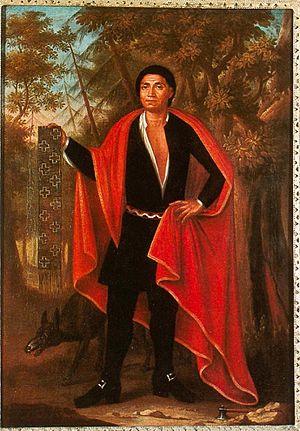Hendrick Tejonihokarawa facts for kids
Hendrick Tejonihokarawa (born around 1660, died around 1735) was an important leader of the Mohawk people. He was also known as Tee Yee Neen Ho Ga Row or Hendrick Peters. He lived in the Province of New York in the early 1700s.
Hendrick was a strong supporter of the English. In 1710, he was one of the "Four Mohawk Kings" who traveled to London. They met with Queen Anne of Great Britain. The chiefs wanted the Queen's help to stop French influence in New York. They also asked for English missionaries to help their people. This important meeting helped the Iroquois Confederacy stay powerful during the colonial period.
Contents
Early Life and Family
Hendrick Tejonihokarawa was born into the Wolf Clan. In the Mohawk and other Iroquois nations, family lines and social standing passed through the mother. This is called a matrilineal system.
His name, "open the door," might mean he had a special job. He may have been responsible for welcoming visitors into the longhouse.
In July 1690, he became a Christian. He was baptized by Godfridius Dellius and joined the Dutch Reformed Church. He was given the name Hendrick Peters. Later, he became a Protestant preacher. He lived in a Mohawk village called Tionondoroge. This village was along the Mohawk River, where Fort Hunter was later built.
Working as a Leader
By 1710, Hendrick Tejonihokarawa may have become a Sharenhowaneh. This was a title for one of the three Wolf Clan sachems (chiefs). The women elders of the clan chose these leaders.
His actions helped create a strong friendship with the English. This friendship helped the Iroquois Confederacy remain a powerful group in North America. He met with English leaders in Albany to protect Mohawk lands. These lands were in the Mohawk River Valley. Other Iroquois nations had lands further west and north.
Meeting Queen Anne
In 1710, Hendrick and two other Mohawk chiefs, plus a Mahican chief, sailed to London. They met with Queen Anne to make a treaty. While in London, Hendrick asked for Anglican missionaries. He wanted them to help balance the French Catholic influence in Iroquois lands.
Years before, the French had damaged Mohawk villages. They had forced the Mohawk people to accept Catholic Jesuits as missionaries. These Jesuits had set up a base near what is now Auriesville, New York. Many Mohawk people who became Catholic moved to a mission village called Kahnawake near Montreal.
In 1711, Queen Anne sent Anglican missionaries to New York. They built a mission and a chapel at Fort Hunter. The nearby Mohawk village soon became mostly Christian.
Helping German Settlers
Queen Anne also asked Hendrick Tejonihokarawa for help. She wanted to resettle Palatine German refugees in New York. These Germans had been working in English camps to pay for their trip to the colony. They wanted their own land.
Through Governor Robert Hunter, Hendrick offered Mohawk land to these refugees. Some Germans settled near Schoharie Creek.
Later Leadership
In the winter of 1712-1713, the Wolf Clan women leaders removed Hendrick from his position. This was likely because of disagreements with the missionaries. However, by 1720, he was back in power. Colonial records show him as a sachem again.
In 1723, a group of 100 Germans received grants of Mohawk land. This land was west of what is now Little Falls. It became known as the Burnetsfield Patent. The Germans started new settlements there. This area was upriver from existing Dutch and English settlements. It was also west of the upper Mohawk village of Canajoharie.
Hendrick Tejonihokarawa also traveled to northern New England. He tried to make alliances with the Abenaki people. However, he was stopped from meeting them. The Abenaki often sided with the French during this time.
For many years, people confused Hendrick Tejonihokarawa with another leader. This other leader was named Hendrick Theyanoguin, who was about 30 years younger.


